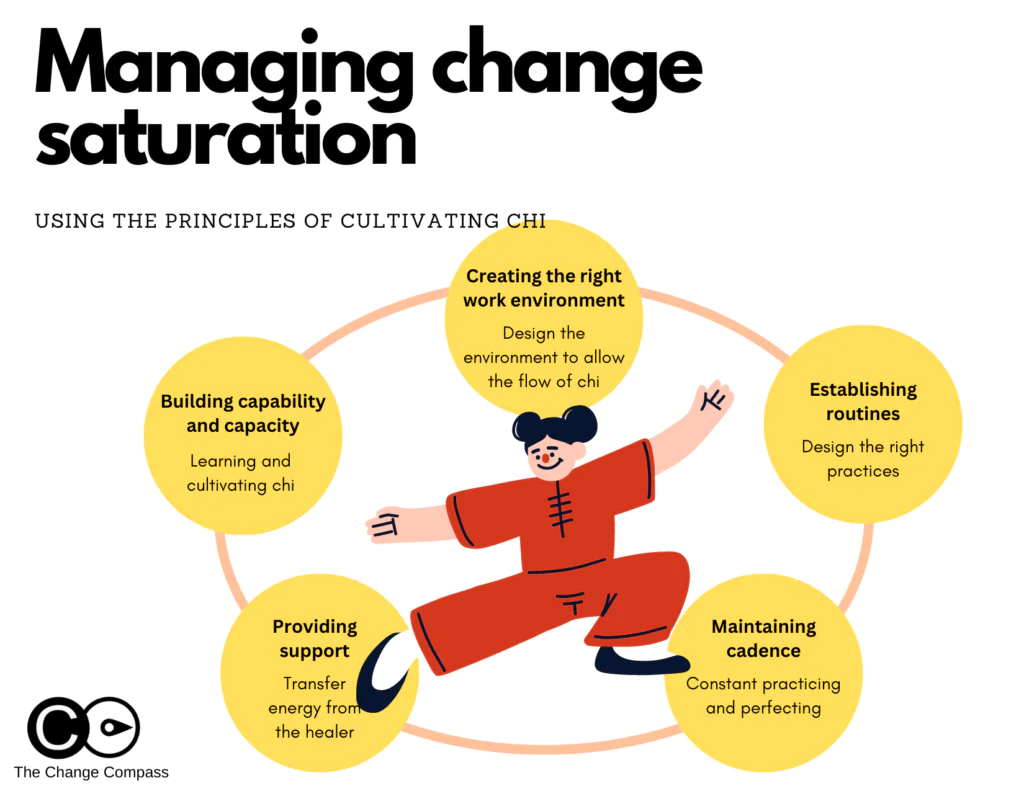Managing change saturation can be tricky. It is not necessarily something you can see or touch. It can be hidden. It can be hearsay. Without the right data organisations can miss the risk. Missing the risk can mean that your organisation suffers from performance drops, and at the same time your changes are not adopted. Managing the risk or presence of change saturation can be complex. In this article we leverage the principles of chi to do this.
Understanding Change Saturation
Managing change saturation is essentially about managing the organizational energy. When an organization experiences too many changes at once, it can lead to fatigue, resistance, and decreased productivity among employees. Just like in traditional Chinese medicine, where the flow of chi, or vital energy, through the body is crucial for good health, the flow and maintenance of energy within an organization is essential for its success.
The Principle of Chi
In Chinese philosophy, chi is the fundamental life force that flows through all living beings and the universe. It is the energy that animates and sustains everything. The concept of chi can be applied to organizations as well, where it represents the energy that drives processes, interactions, and productivity. Chi is recognized as the energy that flows beyond the physical, connecting us with universal energy.
By understanding and applying the principles of chi, organizations can effectively manage their energy and navigate through periods of change without succumbing to saturation. Just as in traditional Chinese medicine, where balance and harmony are essential for optimal health, maintaining balance and harmony within the organization is crucial for its well-being.

Symptoms of Change Saturation
Before delving into techniques for managing change saturation, it’s essential to recognize the symptoms. From an individual perspective, symptoms may include:
- Burnout: Employees may feel overwhelmed and exhausted, leading to decreased motivation and productivity.
- Resistance: There may be increased resistance to change as employees become fatigued from constant transitions.
- Stress: High levels of stress and anxiety can manifest in physical and emotional symptoms such as headaches, insomnia, and irritability.
From an organizational perspective, symptoms may include:
- Decreased Performance: The organization may experience a decline in overall performance and efficiency.
- Increased Turnover: Employees may leave the organization due to stress and burnout.
- Lack of engagement: Employees may not engage with where the organisation is heading and not feel invested.
- Lack of Innovation: Change saturation can stifle creativity and innovation as employees focus on managing constant changes rather than exploring new ideas. During times of anxiety and stress, there is not sufficient mental capacity for innovation.
Recognizing these symptoms is a key step in addressing change saturation and restoring balance to the organization.
Managing Chi in Change Management
Just as traditional Chinese medicine emphasizes practices to cultivate and balance chi within the body, organizations can adopt techniques to manage their energy and navigate through periods of change effectively.
Some of these techniques include:
Building Capability and Capacity:
Building capability in managing change is essential for ensuring that employees have the skills and knowledge needed to navigate through periods of change effectively. This is similar to the process of developing and cultivation chi through learning. In a similar vein, change practitioners can take practical steps to build capability within their organizations which will increase the capacity for change, including:
- Training and Development Programs: Implementing training and development programs focused on change management principles, methodologies, and best practices. These programs can include workshops, seminars, online courses, and coaching sessions to help employees develop the necessary skills and competencies for managing change.
- Change Leadership Development: Investing in the development of change leadership skills among managers and leaders within the organization. Change leaders play a critical role in driving change initiatives forward, communicating effectively with employees, and fostering a culture of openness and adaptability. Leaders have a significant impact on the change outcome so this is critical.
- Mentorship and Coaching: Establishing mentorship and coaching programs where experienced change practitioners can mentor and support employees who are new to change management. This provides valuable guidance and support to individuals as they navigate through change initiatives and develop their skills over time.
- Communities of Practice: Creating communities of practice where change practitioners can come together to share knowledge, experiences, and best practices. These communities provide a platform for collaboration, learning, and networking among individuals with a shared interest in change management.
- On-the-Job Learning Opportunities: Providing employees with opportunities to apply their change management skills in real-world scenarios. This can include participating in change projects, leading change initiatives, and taking on new roles and responsibilities that require them to apply their knowledge and expertise in managing change.
Establishing Routines:
Establishing routines and processes for managing change helps create structure and consistency within the organization. Think of this like exercising to develop the chi. Through exercises chi practitioners can harness the energy flow through controlled movements. Regular practices to cultivate and manage chi are essential. Change practitioners can implement the following practical routines to ensure that change initiatives are effectively managed and monitored:
- Change Readiness Assessments: Conducting regular change readiness assessments to gage the organization’s readiness for upcoming change initiatives. This involves assessing factors such as employee readiness, organizational readiness, and potential barriers to change.
- Effective change communication channels: Having effective communication channels that provide community based information flow and discussions as well as 2-way information sharing between the leadership and employees is critical. Effective communication channels need to be managed and promoted to ensure they are working to support change communication goals.
- Change Governance: A part of practicing change is about regularly reviewing change data and making decisions to improve how change is managed and how change is implemented. This also includes ongoing monitoring of the capacity of change and any risks of change saturation. Ultimately, making the right decision on the prioritisation and sequencing of change has significant impact on change saturation.
- Change Monitoring and Reporting: Establishing mechanisms for monitoring and reporting on the progress of change initiatives. This may include regular status updates and progress reports to feed data requirements of change governance bodies and identify areas for improvement. Collecting and reviewing change data should be viewed as a part of managing business (business as usual) vs. an ‘extra’ task.

Providing Support:
In the manipulation and healing of chi this is about transferring the energy from the healer to the patient to restore balance and health. Techniques like Reiki, Qigong healing, and therapeutic touch are popular forms. Likewise in change management, providing support to employees throughout the change process is essential for mitigating resistance, reducing stress, and fostering a culture of resilience.
Change practitioners can offer practical support in the following ways:
- Change Champion Networks: Establishing change champion networks comprised of enthusiastic and influential employees who can help drive change initiatives forward within their respective teams or departments. Change champions serve as advocates for change, providing support, encouragement, and guidance to their colleagues throughout the change process.
- Change Coaching and Mentoring: Offering one-on-one coaching and mentoring support to employees who may be struggling to adapt to change. This provides individuals with a safe space to express their concerns, seek guidance, and develop coping strategies for managing change effectively.
- Change Support Resources: Providing employees with access to resources and tools to support them through the change process. This may include training materials, job aids, self-help resources, and online support forums where employees can access information, share experiences, and seek assistance from their peers.
- Leadership Support and Involvement: Engaging leaders and managers at all levels of the organization in supporting change initiatives and modeling desired behaviors. Leaders play a crucial role in setting the tone for change, communicating the vision, and demonstrating their commitment to supporting employees through periods of transition.
- Employee Assistance Programs: Offering employee assistance programs (EAPs) or counseling services to employees who may be experiencing stress, anxiety, or other emotional challenges related to change. Providing access to confidential counseling and support services can help employees cope with the emotional impact of change and build resilience over time.
Creating the Right Work Environment:
Managing chi is not just about the individual, it also extends to the environment. To harness good chi, factors such as room layout and the overall design of the environment are also important. The goal is to create an environment where chi can flow freely, bringing balance, health and prosperity.
Creating a supportive work environment can foster chi, and is essential for fostering resilience, innovation, and collaboration within the organization. Change practitioners can take practical steps to create the right work environment for managing change, including:
- Promoting Psychological Safety: Creating a culture of psychological safety where employees feel comfortable expressing their ideas, concerns, and feedback without fear of reprisal or judgment. Psychological safety encourages open communication, trust, and collaboration, which are essential for navigating through periods of change. This needs to be modelled and supported through leaders.
- Encouraging Flexibility and Adaptability: Encouraging flexibility and adaptability among employees by promoting a growth mindset and embracing change as an opportunity for learning and growth. Providing opportunities for employees to develop new skills, explore new roles, and take on new challenges can help foster a culture of resilience and agility within the organization.
- Fostering Collaboration and Teamwork: Fostering a collaborative and inclusive work environment where employees feel valued, respected, and empowered to contribute their unique perspectives and talents. Encouraging cross-functional collaboration, team-building activities, and knowledge sharing helps break down silos and promote a sense of unity and common purpose among employees.
- Providing Adequate Resources and Support: Ensuring that employees have access to the resources, tools, and support they need to succeed in their roles and navigate through periods of change effectively. This may include providing training and development opportunities, allocating sufficient time and resources for change initiatives, and offering ongoing support and guidance from leadership.
- Celebrating Success and Milestones: Celebrating success and milestones along the change journey to recognize the efforts and achievements of employees. Acknowledging progress, rewarding contributions, and celebrating successes helps build morale, motivation, and momentum for future change initiatives.

Maintaining Cadence:
Maintaining a consistent cadence for change initiatives helps prevent overload and fatigue, ensuring that change is managed effectively and sustainably over time. Change practitioners can maintain cadence by:
- Setting Realistic Timelines and Milestones: Setting realistic timelines and milestones for change initiatives based on the organization’s capacity and resources. This involves carefully planning and sequencing change activities to avoid overwhelming employees and minimize disruption to day-to-day operations.
- Prioritizing and Sequencing Change Initiatives: Prioritizing change initiatives based on their strategic importance, urgency, and impact on the organization. This helps focus resources and attention on the most critical changes while ensuring that less urgent changes are managed effectively within the organization’s capacity. The sequencing and design of change impact activities across all initiatives is also critical as this shapes the experiences of employees.
- Maintaining Governance and Oversight: Maintaining the right governance structures and oversight mechanisms to ensure that change initiatives are aligned with organizational goals, objectives, and priorities. This may include ensuring the right change management committees (including the right numbers of committees), capable change sponsors, and conducting regular reviews and assessments as to the effectiveness of the governance bodies.
- Communicating Regularly and Transparently: Communicating regularly and transparently with employees about the status of change initiatives, upcoming milestones, and any changes to plans or timelines. Providing clear and consistent communication helps keep employees informed, engaged, and ensures there are no surprises.
By incorporating these techniques into their change management practices, organizations can effectively manage change saturation and promote a healthy, resilient, and thriving organizational environment. However, one that supports change and is not prone to change saturation.
Change saturation can pose significant challenges for organizations, leading to decreased performance, employee burnout, and resistance to change. By applying the principles of chi and adopting techniques to manage organizational energy, such as developing capability, and cadence and creating the right environment, organizations can navigate through periods of change more effectively and promote a culture of resilience, innovation, and well-being. Just as in traditional Chinese medicine, where balance and harmony are essential for good health, maintaining balance and harmony within the organization is crucial for its success in an ever-changing world.
To read up more about managing change saturation check these out:
How to measure change saturation
4 common assumptions about change saturation that are misleading
Why change saturation is a pandemic for most large organisations






